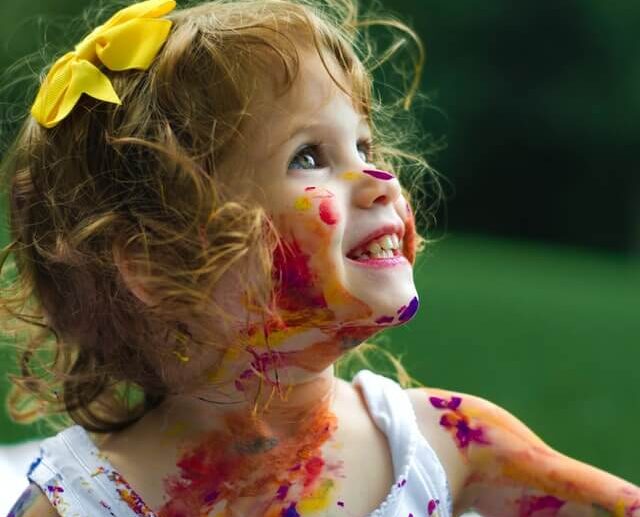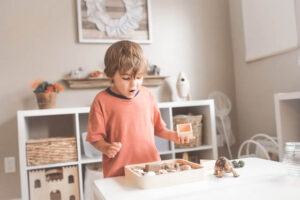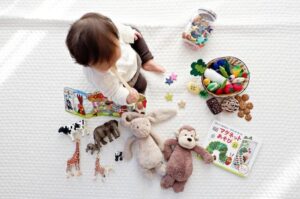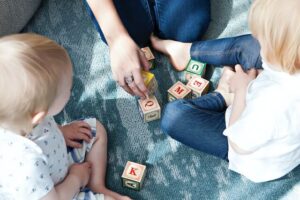
Table of Contents
Creative activities are not only fun for children with autism, but can also help them develop motor skills, increase attention span, and practice communication and social interactions. Continue reading to find out how your child with autism spectrum disorder can learn new skills through play.
Sensory Games for Children with Autism
Sensory bottle
Making a sensory bottle is a fun activity suitable for children with autism of all ages. Everyone from preschoolers to adolescents will appreciate having a colorful bottle to help them with long waits or calm them down after a meltdown. Making a sensory bottle will also keep your child engaged and focused on the task at hand and help increase their attention span.
How to make it
To make a sensory bottle, wash an old plastic water or soda bottle and fill it halfway with water. Add some glitter glue, food coloring, sand, rice, or small beads, using any colors that appeal to your child. Close the lid or glue it in place using a hot glue gun. As your child shakes the bottle, the glitter and beads will twirl and spin through the bottle until they eventually settle on the bottom.
More inspiration
- Sensory and Discovery Bottles. Pinterest board with lots of ideas on making sensory bottles where you can also share your own projects.
- Preschool Inspiration. Learn how to make sensory bottles using a variety of recipients and ingredients.
Edible jewelry
If your child has delayed development of fine motor skills, making edible jewelry is the perfect opportunity to practice intricate hand and finger movements. You can also use this fun activity to teach your child to follow instructions, count, and recognize colors.
How to make it
To make an edible necklace or bracelet, you need a piece of string and an assortment of edible items, such as Fruit Loops, Lifesavers Gummies, marshmallows, or edible play dough that your child can form into beads. Make sure that the string is long enough to fit over your child’s head or wrist when tied. Then simply have your child thread the candy on the string and tie it together.
More inspiration
- Kids Activities Blog. Several different recipes for making your own edible play dough.
- Raised on Veggies. Healthy edible necklaces made of fruit.
Tactile collage
Most children with autism have sensory processing issues. They may find the sensation of different textures overwhelming, a condition known as tactile defensiveness. Creating a tactile collage is a good way to introduce your child to new textures and at the same time have them practice their fine motor skills.
How to make it
Cut a piece of cardboard out of a cereal box and pour some glue into a small jar. Ask your child to glue pre-cut pieces of fabric, aluminum foil, string, or felt onto the cardboard. Your child can apply the glue with a brush to prevent any sensory issues due to getting their hands sticky.
More inspiration
- Crafty Thinking. Plenty of tactile sensory art projects for children.
- The Art of Autism. How to make tactile collage and other art projects for children with autism.
Brain Activities for Children with autism
Matching games
Matching games where your child needs to connect words with corresponding pictures are useful for teaching vocabulary, colors, and numbers. You can easily make your own matching game, download a free template, or purchase ready-made games.
More inspiration
- Special Learning House. Free printable matching games for autistic children.
- Matching Games for Autism. A free app with online matching games.
- Word to Picture Matching Cards. Matching games designed specifically for children with autism.
Smell game
Many children with autism are sensitive to smells. While some children experience smells very intensely, others are under-responsive to odors. In either case, playing a smell game will allow your child to get used to a variety of olfactory sensations and, as an added bonus, help them improve memory and communication skills.
How to make it
Take several small containers, such as jam jars, and fill them with fragrant ingredients. You can use anything from lemon or orange slices to herbs like rosemary or mint, lavender, cinnamon sticks, coffee, rose petals, and vanilla essence. Ask your child to identify each of the smells. Make sure to avoid using any fragrances that you know your child dislikes or is sensitive to.
More inspiration
- The Inspired TreeHouse. Twenty fun activities for children to explore the sense of smell.
- PreKinders. Scented hunt game for preschoolers, including free printables.
Building Social Skills for a child with autsim
Reading books
Children with autism spectrum disorder frequently experience difficulties when it comes to reading and understanding written language. While your child may have no trouble identifying individual words, understanding a text may still be challenging. Reading books together will not only help your child better grasp the meaning of the text, but also develop vocabulary and improve their cognitive skills and concentration.
Tips
- Start with books that have lots of pictures and little text to get your child interested in reading.
- To keep your child engaged, choose books about their favorite subject, for example, trains or insects.
- To make reading more fun, encourage your child to enact the characters while reading.
More inspiration
- Book Riot. Some of the best books for children with autism of all ages.
- Happily Ever Elephants. Books featuring neurodiverse protagonists, including empowering books for autistic children.
Sharing time
Many children with autism have little or no interest in the world around them and prefer to be left alone. Spending time with your child is essential for teaching interaction and communication skills while having fun. A shared moment will also encourage your child to take turns, share toys, engage in role play, and regulate emotions.
More inspiration
- Stages Learning. Learn how to adapt popular games for children with autism.
- Interacting with your child with autism. Tips for parents on how to effectively communicate with an autistic child.
Calming Activities for a Kid with Autism
Fidget toys
Fidgets toys are self-regulation toys that help children with autism focus and remain calm in stressful environments and whenever they are experiencing sensory overload. Fidgets are also useful for easing a transition into new situations or activities and dealing with routine changes.
Tips
- There is an endless choice of fidget toys in all shapes and forms on the market, including tangle toys, stress-less gel balls, koosh balls, magic snakes, and many more.
- Make sure to choose a fidget toy that isn’t too distracting and that doesn’t draw your child’s attention away completely.
Where to buy
- National Autism Resources. A wide range of fidget toys and stress balls for children with autism.
- Sensory Direct. Fidget toys and tactile tangles for children with sensory and concentration issues.
Coloring pages
Coloring pages are great tools that will help your child focus, build fine motor skills, and learn new words. And that’s not all. Coloring according to directions will help your child learn to recognize colors and numbers, follow instructions, and work on task completion.
Tips
- Choose coloring pages with the subject that your child is interested in, whether it’s a superhero, stars and planets, or animals.
- If your child has difficulties with fine motor skills, large or triangular-shaped crayons may be easier to use than regular ones.
More inspiration
- All Kids Network. Free coloring pages organized by category.
- Autism Coloring Book: I See Things Differently With My Superhero Brain (Amazon).
Constructive Play For an child with autism
Puzzles
Puzzles are another good way to help your child with autism improve focus and fine motor skills. If you’re completing a puzzle together, ask them to tell you about what they’re doing. This will help enhance their vocabulary and communication skills, and practice interacting with others.
Tips
- Puzzles can have a calming effect when your child is feeling restless or overwhelmed.
- Make sure to choose a puzzle with a suitable difficulty level, otherwise, your child may quickly lose interest.
Where to buy
- Autism-Products.com. A wide range of puzzles designed for autistic children.
- Autism Community Store. Peg and knob, magnetic, and other puzzles for children with autism spectrum disorder.
Building blocks
Children with autism appreciate structured and predictable activities. Playing with building blocks is the ideal activity for autistic kids as the blocks come in limited shapes and sizes and the building process requires repetitive movements. This activity can help improve your child’s fine motor skills, in addition to encouraging them to practice verbal and nonverbal communication, sharing, taking turns, and problem solving.
Where to buy
- Strictly Bricks. Building blocks suitable for children with autism.
- BizyBeez Magnetic Building Blocks. Magnetic building blocks for autistic kids.
Physical Play For an Autistic Kid
Dancing
Dancing is a fun and relaxing activity for children with autism. It is beneficial not only for boosting body image and self awareness, but also for improving concentration and memory, enhancing communication skills, increasing empathy, and developing the ability to adapt to different situations.
Tips
- To encourage your child to dance, let them start with free movement and move to the music any way they wish.
- Do movement prompt exercises where you ask your child to freeze when the music stops, move only one part of the body, or make large or small movements.
- Children love dancing to songs with actions like “If You’re Happy and You Know It” or “Hokey Pokey.” This is also a good way to practice following instructions and improve gross motor skills.
More inspiration
Exercise
Many children with autism have limited gross motor function, strength, and coordination. Engaging in regular physical activity will not only allow your child to improve motor skills and overall health, but also to enjoy a variety of activities together with family and friends.
Physical activity has been shown to enhance a general feeling of well-being and counterbalance depression and anxiety in children with autism, in addition to improving their learning and social skills. What’s more, exercising can also decrease repetitive behaviors, such as body rocking, spinning, and head-nodding.
Tips
- Ideally, your child should be doing at least an hour of physical activity every day.
- Start with short exercises to then gradually expand the amount of time your child spends doing physical activities.
- Make exercising fun by playing games that encourage your child to move in different ways, for example, run, jump, hop, and skip.
- A simple way to add some physical activity into your child’s daily routine is to walk to school and make daily trips to the playground.
More inspiration
- Gympanzees. Workout and exercise videos for autistic children.
- Special Learning House. Ten exercises specifically designed for children with autism.
Obstacle courses
Obstacle courses are one of the best ways for your child to practice their gross motor skills, balance, strength, and coordination, while having fun. If your child has challenges with motor planning and sequencing, this activity will provide them with an opportunity to work on completing a task.
How to make it
To make an obstacle course, you can use anything from mats and foam shapes to chairs, ladders, and hula hoops, or any other objects you may find in your home or garden. Make sure to incorporate a variety of activities such as bean bag tossing, throwing and catching a ball, and jumping ropes. Your child can try walking on an uneven surface, stand or hop on one foot, push or pull heavy items, do push ups or sit ups, do jumping jacks, or run around cones.
Tips
- Always explain the obstacle course to your child in advance and give it a practice run to let them know what to expect and avoid frustration.
- An obstacle course can be designed to target specific motor and cognitive skills that your child needs to practice. Activities can range from simple to more challenging, depending on your child’s developmental level.
More inspiration
- Love to Know. Fun obstacle course ideas for children with autism.
- Autism Adventures. Sensory obstacle courses for autistic kids.
If you are ready to work with the best ABA therapy provider in New York, New Jersey or Indiana, give us a call at (732) 402-0297. Our dedicated team is ready to help and we will treat you like family.
- Autism Routine Disruption in Adults: Coping Tips - July 16, 2024
- Autism and Obsession: An Overview - July 16, 2024
- Autism and Taking Clothes Off: Management Tips - July 16, 2024



